Occupy Wall Street

Occupy Wall Street

| Occupy Wall Street | |
|---|---|
| Part of the Occupy movement | |
| Date | September 17, 2011 (2011-09-17) |
| Location | New York City 40°42′33.79″N 74°0′40.76″W [309] |
| Caused by | Wealth inequality, political corruption,[3] corporate influence of government |
| Methods |
|
| Number | |
Zuccotti Park
Other activity in NYC:
| |
Occupy Wall Street (OWS) was a protest movement that began on September 17, 2011, in Zuccotti Park, located in New York City's Wall Street financial district, against economic inequality.[9]
The Canadian anti-consumerist and pro-environment group/magazine Adbusters initiated the call for a protest. The main issues raised by Occupy Wall Street were social and economic inequality, greed, corruption and the undue influence of corporations on government—particularly from the financial services sector. The OWS slogan, "We are the 99%", refers to income and wealth inequality in the U.S. between the wealthiest 1% and the rest of the population. To achieve their goals, protesters acted on consensus-based decisions made in general assemblies which emphasized redress through direct action over the petitioning to authorities.[10][1]
The protesters were forced out of Zuccotti Park on November 15, 2011. Protesters turned their focus to occupying banks, corporate headquarters, board meetings, foreclosed homes, and college and university campuses.
| Occupy Wall Street | |
|---|---|
| Part of the Occupy movement | |
| Date | September 17, 2011 (2011-09-17) |
| Location | New York City 40°42′33.79″N 74°0′40.76″W [309] |
| Caused by | Wealth inequality, political corruption,[3] corporate influence of government |
| Methods |
|
| Number | |
Zuccotti Park
Other activity in NYC:
| |
Origins
The original protest was called for by Kalle Lasn and Micah White of Adbusters, a Canadian anti-consumerist publication, who conceived of a September 17 occupation in Lower Manhattan. The first such proposal appeared on the Adbusters website on February 2, 2011, under the title "A Million Man March on Wall Street."[11] Lasn registered the OccupyWallStreet.org web address on June 9.[12] That same month, Adbusters emailed its subscribers saying "America needs its own Tahrir." White said the reception of the idea "snowballed from there".[12][13] In a blog post on July 13, 2011,[14] Adbusters proposed a peaceful occupation of Wall Street to protest corporate influence on democracy, the lack of legal consequences for those who brought about the global crisis of monetary insolvency, and an increasing disparity in wealth.[13] The protest was promoted with an image featuring a dancer atop Wall Street's iconic Charging Bull statue.[15][16][17]
Meanwhile, several similar proposals were being explored by independent groups, as reported by journalist Nathan Schneider in his book Thank You, Anarchy: Notes from the Occupy Apocalypse.[18] Thousands of people organized by a group of labor unions marched on Wall Street 12; the online collective Anonymous attempted an occupation on June 14; activists planned an indefinite occupation of Freedom Plaza in Washington, D.C., which eventually became known as Occupy Washington, D.C.; in New York City a group of protestors met for several months to plan an occupation which was originally to be stationed at Chase Plaza, with Zucotti Park as "Plan B".
On August 1, 2011, almost a month prior to the major media event, a group of artists were arrested after a series of days protesting nude as an art performance on Wall Street.[19] This event may have inspired or triggered the major event to follow. This was a protest by the 49 participants on American Institutions and was titled "Ocularpation: Wall Street" by artist Zefrey Throwell.[20]
Then in an unrelated incident, a group called New Yorkers Against Budget Cuts (NYAB) was formed, which promoted a "sleep in" in lower Manhattan called "Bloombergville", in July 2011, preceding OWS, and provided a number of activists to begin organizing.[21][22] Activist, anarchist and anthropologist David Graeber and several of his associates attended the NYAB general assembly but, disappointed that the event was intended to be a precursor to marching on Wall Street with predetermined demands, Graeber and his small group created their own general assembly, which eventually developed into the New York General Assembly. The group began holding weekly meetings to work out issues and the movement's direction, such as whether or not to have a set of demands, forming working groups and whether or not to have leaders.[12][23][24][2] The Internet group Anonymous created a video encouraging its supporters to take part in the protests.[25] The U.S. Day of Rage, a group that organized to protest "corporate influence [that] corrupts our political parties, our elections, and the institutions of government", also joined the movement.[26][27] The protest itself began on September 17; a Facebook page for the demonstrations began two days later on September 19 featuring a YouTube video of earlier events. By mid-October, Facebook listed 125 Occupy-related pages.[28]
The original location for the protest was One Chase Manhattan Plaza, with Bowling Green Park (the site of the "Charging Bull") and Zuccotti Park as alternate choices. Police discovered this before the protest began and fenced off two locations; but they left Zuccotti Park, the group's third choice, open. Since the park was private property, police could not legally force protesters to leave without being requested to do so by the property owner.[29][30] At a press conference held the same day the protests began, New York City mayor Michael Bloomberg explained, "people have a right to protest, and if they want to protest, we'll be happy to make sure they have locations to do it."[27]
Because of its connection to the financial system, lower Manhattan has seen many riots and protests since the 1800s,[31] and OWS has been compared to other historical protests in the United States.[32] Commentators have put OWS within the political tradition of other movements that made themselves known by occupation of public spaces, such as Coxey's Army in 1894, the Bonus Marchers in 1932, and the May Day protesters in 1971.[33][34]
More recent prototypes for OWS include the British student protests of 2010, 2009-2010 Iranian election protests, the Arab Spring protests,[35] and, more closely related, protests in Chile, Greece, Spain and India. These antecedents have in common with OWS a reliance on social media and electronic messaging,[36][37] as well as the belief that financial institutions, corporations, and the political elite have been malfeasant in their behavior toward youth and the middle class.[38][39] Occupy Wall Street, in turn, gave rise to the Occupy movement in the United States.[40][41][42] David Graeber has argued that the Occupy movement, in its anti-hierarchical and anti-authoritarian consensus-based politics, its refusal to accept the legitimacy of the existing legal and political order, and its embrace of prefigurative politics, has roots in an anarchist political tradition.[43] Sociologist Dana Williams has likewise argued that "the most immediate inspiration for Occupy is anarchism", and the LA Times has identified the "controversial, anarchist-inspired organizational style" as one of the hallmarks of OWS.[44][45]
Background
"We are the 99%"
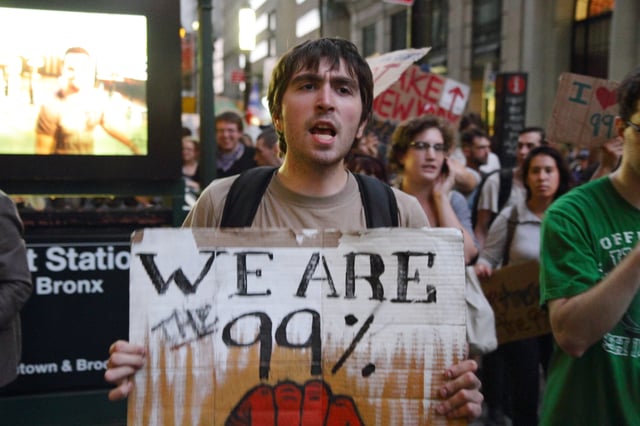
"We Are The 99%"
The Occupy protesters' slogan "We are the 99%" referred to the protester's perceptions of, and attitudes regarding, income disparity in the US and economic inequality in general, which were main issues for OWS. It derives from a "We the 99%" flyer calling for OWS's second General Assembly in August 2011. The variation "We are the 99%" originated from a tumblr page of the same name.[46][47] Huffington Post reporter Paul Taylor said the slogan was "arguably the most successful slogan since 'Hell no, we won't go!'" of the Vietnam War era, and that the majority of Democrats, independents and Republicans saw the income gap as causing social friction.[46] The slogan was boosted by statistics which were confirmed by a Congressional Budget Office (CBO) report released in October 2011.[48]
Income and wealth inequality
Income inequality and Wealth Inequality were focal points of the Occupy Wall Street protests.[54][55][56] This focus by the movement was studied by Arindajit Dube and Ethan Kaplan of the University of Massachusetts Amherst, who noted that "inequality in the U.S. has risen dramatically over the past 40 years. So it is not too surprising to witness the rise of a social movement focused on redistribution ... Greater inequality may reflect as well as exacerbate factors that make it relatively more difficult for lower-income individuals to mobilize on behalf of their interests ... Yet, even the economic crisis of 2007 did not initially produce a left social movement ... Only after it became increasingly clear that the political process was unable to enact serious reforms to address the causes or consequences of the economic crisis did we see the emergence of the OWS movement ... Overall, a focus on the 1 percent concentrates attention on the aspect of inequality most clearly tied to the distribution of income between labor and capital ... We think OWS has already begun to influence the public policy making process."[57]
An article on the same subject published in Salon Magazine by Natasha Leonard noted "Occupy has been central to driving media stories about income inequality in America. Late last week, Radio Dispatch's John Knefel compiled a report for media watchdog Fairness and Accuracy in Reporting (FAIR), which illustrates Occupy's success: Media focus on the movement in the past half year, according to the report, has been almost directly proportional to the attention paid to income inequality and corporate greed by mainstream outlets. During peak media coverage of the movement last October, mentions of the term "income inequality" increased "fourfold"... tokens of Occupy rhetoric — most notably the idea of a "99 percent" against a "1 percent" — has seeped into everyday cultural parlance."[58] As income inequality remained on people's minds, Republican Presidential Candidate Mitt Romney said such a focus was about envy and class warfare.[59]
Goals
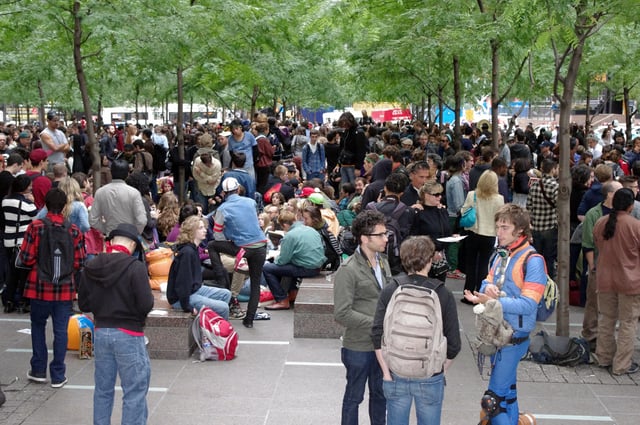
Beginning on September 17, 2011, Zuccotti Park was occupied by protesters.[60]
OWS's goals included a reduction in the influence of corporations on politics,[61] more balanced distribution of income,[61] more and better jobs,[61] bank reform[42] (especially to curtail speculative trading by banks [310] ), forgiveness of student loan debt[61][62] or other relief for indebted students,[63][64] and alleviation of the foreclosure situation.[65] Some media labeled the protests "anti-capitalist",[66] while others disputed the relevance of this label.[67] Nicholas Kristof of The New York Times noted "while alarmists seem to think that the movement is a 'mob' trying to overthrow capitalism, one can make a case that, on the contrary, it highlights the need to restore basic capitalist principles like accountability".[68] Rolling Stone writer Matt Taibbi asserted, "These people aren't protesting money. They're not protesting banking. They're protesting corruption on Wall Street."[69] In contradiction to such views, academic Slavoj Zizek wrote, "capitalism is now clearly re-emerging as the name of the problem,"[70] and Forbes columnist Heather Struck wrote, "In downtown New York, where protests fomented, capitalism is held accountable for the dire conditions that a majority of Americans face amid high unemployment and a credit collapse that has ruined the housing market and tightened lending among banks."[71]
Some protestors favored a fairly concrete set of national policy proposals.[72][73] One OWS group that favored specific demands created a document entitled the 99 Percent Declaration,[74] but this was regarded as an attempt to "co-opt" the "Occupy" name,[75] and the document and group were rejected by the General Assemblies of Occupy Wall Street and Occupy Philadelphia.[75] However others, such as those who issued the Liberty Square Blueprint, are opposed to setting demands, saying they would limit the movement by implying conditions and limiting the duration of the movement.[76] David Graeber, an OWS participant, also criticized the idea that the movement must have clearly defined demands, arguing that it would be a counterproductive legitimization of the power structures the movement sought to challenge.[77] In a similar vein, scholar and activist Judith Butler challenged the assertion that OWS should make concrete demands: "So what are the demands that all these people are making? Either they say there are no demands and that leaves your critics confused. Or they say that demands for social equality, that demands for economic justice are impossible demands and impossible demands are just not practical. But we disagree. If hope is an impossible demand then we demand the impossible."[78] Regardless, activists favored a new system that fulfills what is perceived as the original promise of democracy to bring power to all the people.[79]
Protester demographics
Early on the protesters were mostly young.[82][83] As the protest grew, older protesters also became involved.[84] The average age of the protesters was 33, with people in their 20s balanced by people in their 40s.[85] Various religious faiths have been represented at the protest including Muslims, Jews, and Christians.[86] Rabbi Chaim Gruber,[87] however, is reportedly the only clergy member to have actually camped at Zuccotti Park.[88][89][90] The Associated Press reported in October that there was "diversity of age, gender and race" at the protest.[84] A study based on survey responses at OccupyWallSt.org reported that the protesters were 81.2% White, 6.8% Hispanic, 2.8% Asian, 1.6% Black, and 7.6% identifying as "other".[91][92]
According to a survey of occupywallst.org website visitors[93] by the Baruch College School of Public Affairs published on October 19, of 1,619 web respondents, one-third were older than 35, half were employed full-time, 13% were unemployed and 13% earned over $75,000. When given the option of identifying themselves as Democratic, Republican or Independent/Other 27.3% of the respondents called themselves Democrats, 2.4% called themselves Republicans, while the rest, 70%, called themselves independents.[94] A study released by City University of New York found that over a third of protesters had incomes over $100,000, 76% had bachelor's degrees, and 39% had graduate degrees. While a large percent of them were employed, they largely reported they were "unconstrained by highly demanding family or work commitments". The study also found that they disproportionally represented upper-class, highly educated white males.[95][96] A survey of 301 respondents by a Fordham University political science professor identified the protester's political affiliations as 25% Democratic, 2% Republican, 11% Socialist, 11% Green Party, 0% Tea Party, and 12% "Other"; meanwhile, 39% of the respondents said they did not identify with any political party.[97] Ideologically the Fordham survey found 39% self-identifying as extremely liberal, 33% as Liberal, 8% as slightly liberal, 15% as moderate/"middle of the road", 2% as slightly conservative, 3% as conservative, and 1% as extremely conservative.[98]
Main organization
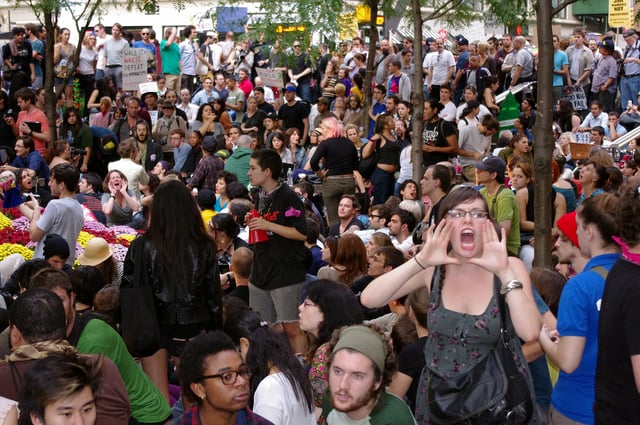
Protesters engaging in the 'human microphone'
The assembly was the main OWS decision-making body and used a modified consensus process, where participants attempted to reach consensus and then dropped to a 9/10 vote if consensus was not reached.
Assembly meetings involved OWS working groups and affinity groups, and were open to the public for both attendance and speaking.[99] The meetings lacked formal leadership. Participants commented upon committee proposals using a process called a "stack", which is a queue of speakers that anyone can join. New York used a progressive stack, in which people from marginalized groups are sometimes allowed to speak before people from dominant groups. Facilitators and "stack-keepers" urge speakers to "step forward, or step back" based on which group they belong to, meaning that women and minorities often moved to the front of the line, while white men often had to wait for a turn to speak.[100][101] In addition to the over 70 working groups,[102] the organizational structure also includes "spokes councils", at which every working group can participate.[103]
Funding
During the initial weeks of the park encampment it was reported that most of OWS funding was coming from donors with incomes in the $50,000 to $100,000 range, and the median donation was $22.[85] According to finance group member Pete Dutro, OWS had accumulated over $700,000.[104] The largest single donor to the movement was former New York Mercantile Exchange vice chairman Robert Halper, who was noted by media as having also given the maximum allowable campaign contribution to Republican presidential candidate Mitt Romney.[105] During the period that protesters were encamped in the park the funds were being used to purchase food and other necessities and to bail out fellow protesters. With the closure of the park to overnight camping on November 15, members of the OWS finance committee stated they would initiate a process to streamline the movement and re-evaluate their budget and eliminate or merge some of the "working groups" they no longer needed on a day-to-day basis.[106][107]
Met with increasing costs and significant overhead expenses in order to sustain the movement, an internal audit from the fiscal management team known as the "accounting working group" revealed on March 2, 2012, that only $44,000 of the several hundred thousand dollars raised still remained available. The report warned that if current revenues and expenses were maintained at current levels, then funds would run out in three weeks.[108][109] Some of the movement's biggest costs include ground-level activities such as food kitchens, street medics, bus tickets, subway passes, and printing expenses.[110][111]
In late February 2012 it was reported that a group of business leaders including Ben Cohen, Jerry Greenfield, Danny Goldberg, Norman Lear, and Terri Gardner[112] created a new working group, the Movement Resource Group, and with it have pledged $300,000 with plans to add $1,500,000 more.[113][114] The money would be made available in the form of grants of up to $25,000 for eligible recipients.
The People's Library
The People's Library at Occupy Wall Street was started a few days after the protest when a pile of books was left in a cardboard box at Zuccotti Park. The books were passed around and organized, and as time passed, it received additional books and resources from readers, private citizens, authors and corporations.[115] As of November 2011 the library had 5,554 books cataloged in LibraryThing and its collection was described as including some rare or unique articles of historical interest.[116] According to American Libraries, the library's collection had "thousands of circulating volumes", which included "holy books of every faith, books reflecting the entire political spectrum, and works for all ages on a huge range of topics."[115]
Following the example of the OWS People's Library, protesters throughout North America and Europe formed sister libraries at their encampments.[117]
Zuccotti Park encampment
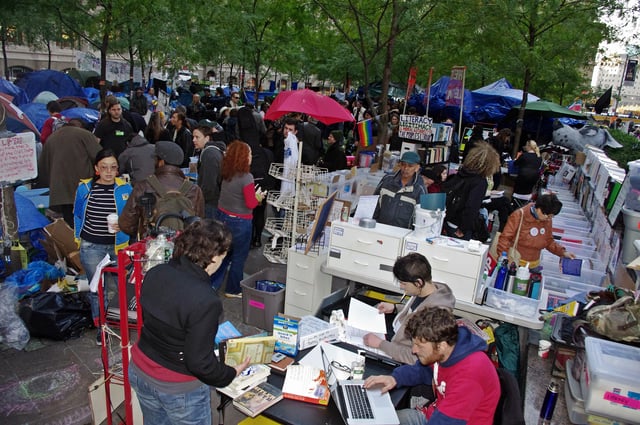
Encampment at Zuccotti Park and "People's Library" with over 5,000 books, wi-fi internet, and a reference service, often staffed by professional librarians, procuring material through the interlibrary loan system.
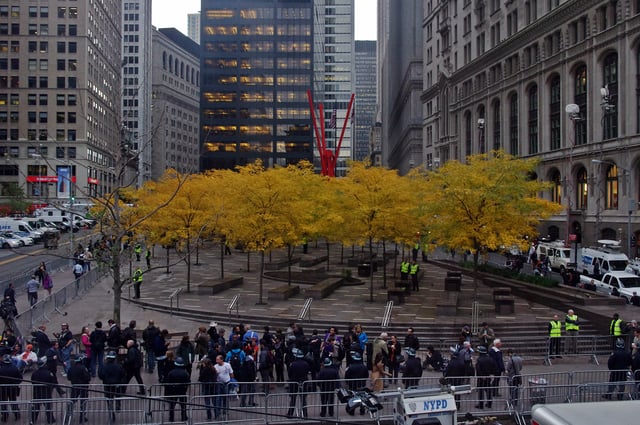
Zuccotti Park, cleared and cleaned on November 15, 2011

Rage Against the Machine guitarist Tom Morello playing Occupy Wall Street in New York, October 2011
Prior to being closed to overnight use and during the occupation of the space, somewhere between 100 and 200 people slept in Zuccotti Park. Initially tents were not allowed and protesters slept in sleeping bags or under blankets.[118] Meal service started at a total cost of about $1,000 per day. While some visitors ate at nearby restaurants, according to the Wall Street Journal and the New York Post many businesses surrounding the park were adversely affected.[119][120][121] Contribution boxes collected about $5,000 a day, and supplies came in from around the country.[119] Eric Smith, a local chef who was laid off at the Sheraton in Midtown, said that he was running a five-star restaurant in the park.[122] In late October, kitchen volunteers complained about working 18-hour days to feed people who were not part of the movement and served only brown rice, simple sandwiches, and potato chips for three days.[123]
Many protesters used the bathrooms of nearby business establishments. Some supporters donated use of their bathrooms for showers and the sanitary needs of protesters.[124]
New York City requires a permit to use "amplified sound", including electric bullhorns. Since Occupy Wall Street did not have a permit, the protesters created the "human microphone" in which a speaker pauses while the nearby members of the audience repeat the phrase in unison. The effect has been called "comic or exhilarating—often all at once." Some feel this provided a further unifying effect for the crowd.[125][118]
During the weeks that overnight use of the park was allowed, a separate area was set aside for an information area which contained laptop computers and several wireless routers.[126][127] The items were powered with gas generators until the New York City Fire Department removed them on October 28, saying they were a fire hazard.[128] Protesters then used bicycles rigged with an electricity-generating apparatus to charge batteries to power the protesters' laptops and other electronics.[129][130] According to the Columbia Journalism Review's New Frontier Database, the media team, while unofficial, ran websites like Occupytogether.org, video livestream, a "steady flow of updates on Twitter, and Tumblr" as well as Skype sessions with other demonstrators.[131]
On October 6, Brookfield Office Properties, which owns Zuccotti Park, issued a statement saying: "Sanitation is a growing concern ... Normally the park is cleaned and inspected every weeknight [but] because the protesters refuse to cooperate ... the park has not been cleaned since Friday, September 16 and as a result, sanitary conditions have reached unacceptable levels."[132][133]
On October 13, New York City's mayor Bloomberg and Brookfield announced that the park must be vacated for cleaning the following morning at 7 am.[134] However, protesters vowed to "defend the occupation" after police said they would not allow them to return with sleeping bags and other gear following the cleaning, and many protesters spent the night sweeping and mopping the park.[135][136] The next morning the property owner postponed its cleaning effort.[135] Having prepared for a confrontation with the authorities to prevent the cleaning effort from proceeding, some protesters clashed with police in riot gear outside City Hall after it was canceled.[134] MTV followed two protesters for their series True Life; one of whom, Bryan, was on the sanitation crew. Filming took place during the time when the cleanup happened.[137]
On October 20, residents at a community board meeting complained about inadequate sanitation, verbal taunts and harassment by protesters, noise, and related issues. One resident angrily complained that the protesters "[a]re defecating on our doorsteps"; board member Tricia Joyce said, "They have to have some parameters. That doesn't mean the protests have to stop. I'm hoping we can strike a balance on parameters because this could be a long term stay."[138]
Shortly after midnight on November 15, 2011, the New York City Police Department gave protesters notice from the park's owner (Brookfield Office Properties) to leave Zuccotti Park due to its purportedly unsanitary and hazardous conditions. The notice stated that they could return without sleeping bags, tarps or tents.[139][140] About an hour later, police in riot gear began removing protesters from the park, arresting some 200 people in the process, including a number of journalists.
On December 31, 2011, protesters started to re-occupy the park. At one point, protesters started to push police barricades into the streets. Police quickly put the barricades back up. Occupiers then started to take down barricades from all sides of the park and stored them in a pile in the middle of Zuccotti Park.[141] Police called in reinforcements as more activists entered the park. Police tried to enter the park but were pushed back by protesters. There were reports of pepper-spray being used by the police. At about 12:40 am, after the group celebrated New Years in the park, they exited the park and marched down Broadway. Police in riot gear started to clear out the park around 1:30 am. Sixty-eight people were arrested in connection with the event, including one accused of stabbing a police officer in the hand with a pair of scissors.[142]
Since the closure of the Zuccotti Park encampment, some former campers were allowed to sleep in local churches, but how much longer they will be welcomed is in question, and even former park occupiers debate whether or not they can continue to provide funds and meals for homeless protesters. Since the removal, New York protesters have been divided in their opinion as to the importance of the occupation of a space, with some believing that actual encampment is unnecessary, and even a burden.[143] Since the closure of the Zuccotti Park encampment, the movement has turned its focus on occupying banks, corporate headquarters, board meetings, foreclosed homes, college and university campuses, and Wall Street itself. Since its inception, the Occupy Wall Street protests in New York City have cost the city an estimated $17 million in overtime fees to provide policing of protests and encampment inside Zuccotti Park.[144][145][146]
On March 17, 2012, Occupy Wall Street demonstrators attempted to mark the movement's six-month anniversary by reoccupying Zuccotti Park. Protesters were soon cleared away by police, who made over 70 arrests. Veteran protesters said the force used by police was the most violent they had witnessed and a Guardian reporter witnessed a protester being slammed into a glass door by a police officer.[147][148] On March 24, hundreds of OWS protesters marched from Zuccotti Park to Union Square in a demonstration against police violence.[149]
On September 17, 2012, protesters returned to Zuccotti Park to mark the one-year anniversary of the beginning of the occupation. Protesters blocked access to the New York Stock Exchange as well as other intersections in the area. This, along with several violations of Zuccotti Park rules, led police to surround groups of protesters, at times pulling protesters from the crowds to be arrested for blocking pedestrian traffic. A police lieutenant instructed reporters not to take pictures. The New York Times reported that two officers shoved city councilman Jumaane D. Williams off a bench with batons after he refused two orders to move. A spokesman for Williams later stated that he had been pushed by police while trying to explain his reason for being in the park, but was not arrested or injured. There were 185 arrests across the city.[150][151][152][153]
Occupy media
Occupy Wall Street activists disseminated their movement updates through variety of mediums, including social media, print magazines, newspapers, film, radio and live stream. Like much of Occupy, many of these alternative media projects were collectively managed, while autonomous from the decision making bodies of Occupy Wall Street.[154][155]
Occupied Media Pamphlet Series
Occupied Media Pamphlet Series, published by Zuccotti Park Press was co-founded by Open Magazine Pamphlet Series and Adelante Alliance. A published series of 5 mini-books available for purchase, by different renowned academics and activists offering their perspectives and visions for the Occupy movement. Occupy, the first book in the series, by Noam Chomsky was launched on May 1, 2012.[156]
Chomsky, Noam (2012). Occupy: Reflections on Class War, Rebellion and Solidarity. Occupied Media Pamphlet Series. Zuccotti Park Press. ISBN 978-1884519017.
Sitrin, Marina; Azzellini, Dario (2012). Occupying Language: The Secret Rendezvous with History and the Present. Zuccotti Park Press. ISBN 978-1884519093.
Abu-Jamal, Mumia; Walker, Alice (2012). Message to the Movement. Zuccotti Park Press. ISBN 978-1884519079.
Leonard, Stuart (2012). Taking Brooklyn Bridge. Zuccotti Park Press. ISBN 978-1884519055.
Gottesdiener, Laura (2013). A Dream Foreclosed: Black America and the Fight for a Place to Call Home. Zuccotti Park Press. ISBN 978-1884519215.
Occupied Wall Street Journal
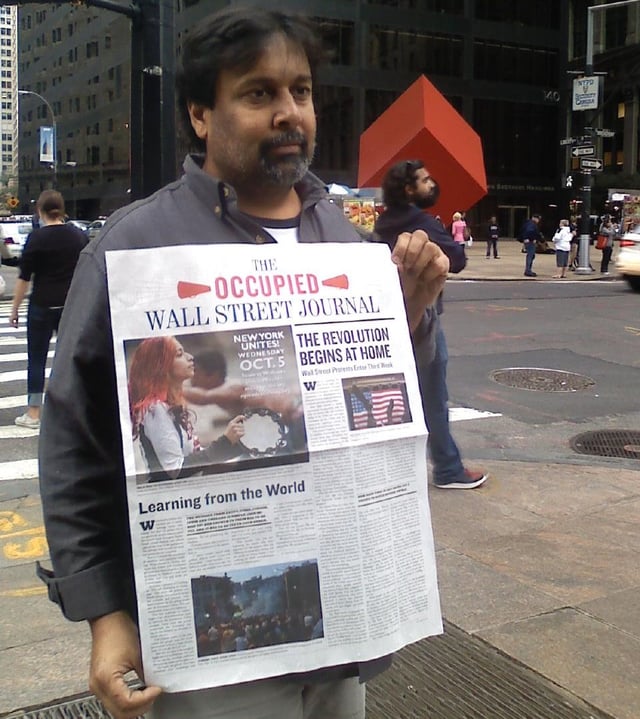
Arun Gupta, editor of Occupied Wall Street Journal holding a copy of the first issue, standing inside Zuccotti Park.
The Occupied Wall Street Journal (OWSJ) was a free newspaper founded in October 2011 by independent journalists Arun Gupta, Jed Brandt and Michael Levitin.[157] Over $75,000 was raised through Kickstarter to fund the distribution and printing of the newspaper. Indypendent Media provided the printing facilities.[158][159] It featured the voices of prominent activist/academics as well as lesser known members of the 99% in four page color issues.[160] The first issue had a total print run of 70,000 copies, along with an unspecified number in Spanish.[161] Its last article appeared in February 2012.
Occuprint
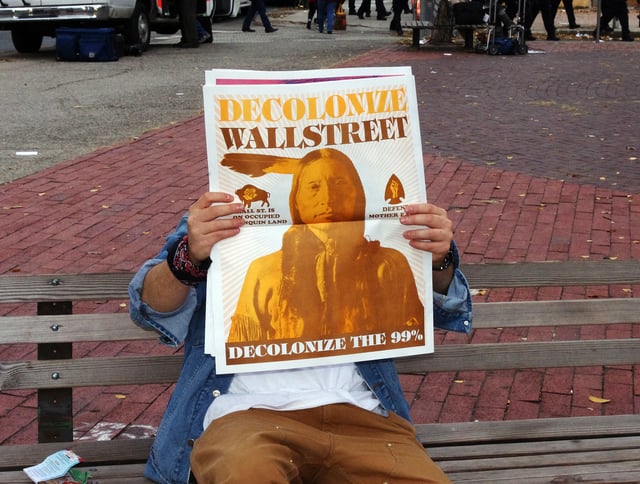
Occupier reading the special edition of Occupied Wall Street, with posters curated by Occuprint.
The Occuprint collective, founded by Jesse Goldstein and Josh MacPhee, formed through the curation of the fourth and special edition of The Occupied Wall Street Journal (OWSJ), featuring 21 posters and graphics highlighting Occupy art.[163][164] Afterwards, it continued to collect and publish images under the Creative Commons for non commercial use license, to spread the artwork throughout the movement. In addition to sending out posters across the different Occupy encampments, Occuprint collaborated with the OWS Screen Printing Guild to make buttons and silk screen clothing free of cost.[165][166]
Jesse Goldstein, Dave Loewenstein, Alexandra Clotfelter and Marshall Weber of Booklyn Artist Alliance selected 31 hand silk-screened prints out of hundreds of submissions, with the goal that limited editions of them end up in museums, libraries, archive centers and universities, preserving and sharing Occupy's legacy. Tens of thousands more copies were distributed for free across the country to different Occupy groups.[167][168] In October 2013, the Museum of Modern Art confirmed it acquired the originals of the Occuprint portfolio.[169]
As part of the Occupy Sandy disaster response to Hurricane Sandy, Occuprint created a 12-page resource pamphlet on how to survive and seek help, after determining that the FEMA booklets were incomplete. 6,000 copies were made in first print run, with a total circulation of 12,000.[170][171]
Occupy! Gazette
The Occupy! Gazette was founded by editors Astra Taylor, Keith Gessen of N+1 and Sarah Leonard of Dissent Magazine. It published five issues from October 2011 to September 2012,[172] with a commemorative sixth issue published in May 2014, to support OWS activist Cecily McMillan during the sentencing phase of her trial.[173][174] Each issue ranged from thirty to forty pages and was featured in a different color theme each time.
Articles from Occupy! were later anthologized in a book titled Occupy!: Scenes From Occupied America, published by Verso Books in 2012.[175]
Tidal
Tidal: Occupy Theory, Occupy Strategy magazine was published twice a year, with its first release in December 2011, the fourth and final issue in March 2013. It consisted of long essays, poetry and art within thirty pages. Each issue had a circulation of 12,000 to 50,000.[176]
Security, crime and legal issues
NYPD spokesman Paul Browne said protesters delayed reporting crime until three complaints were made against the same individual.[179] The protesters denied a "three strikes policy", and one protester told the New York Daily News that he had heard police respond to an unspecified complaint by saying, "You need to deal with that yourselves".[180]
After several weeks of occupation, protesters had made enough allegations of rape, sexual assault, and gropings that women-only sleeping tents were set up.[181][182][183][184] Occupy Wall Street organizers released a statement regarding the sexual assaults stating, "As individuals and as a community, we have the responsibility and the opportunity to create an alternative to this culture of violence, We are working for an OWS and a world in which survivors are respected and supported unconditionally ... We are redoubling our efforts to raise awareness about sexual violence. This includes taking preventative measures such as encouraging healthy relationship dynamics and consent practices that can help to limit harm."[185]
It was revealed that an internal Department of Homeland Security report warned that Occupy Wall Street protests were a potential source of violence; the report stated that "mass gatherings associated with public protest movements can have disruptive effects on transportation, commercial, and government services, especially when staged in major metropolitan areas". The DHS keeps a file on the movement and monitors social media for information, according to leaked emails released by WikiLeaks.[186][187]
Government crackdowns
Surveillance

An internal document of the United States Department of Homeland Security showed that the U.S. government was keeping tabs on protesters
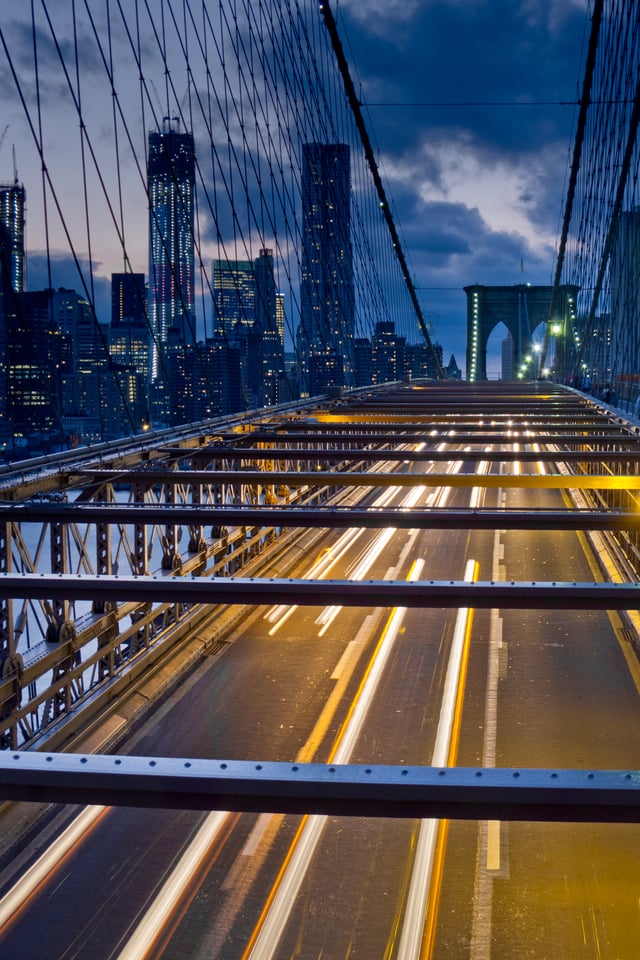
Site where the Brooklyn Bridge Arrest took place
As the movement spread across the United States, the United States Department of Homeland Security (DHS) began keeping tabs on protesters. A DHS report entitled "SPECIAL COVERAGE: Occupy Wall Street", dated October 2011, observed that "mass gatherings associated with public protest movements can have disruptive effects on transportation, commercial, and government services, especially when staged in major metropolitan areas."[188]
On December 21, 2012, Partnership for Civil Justice obtained and published U.S. government documents[189] revealing that over a dozen local FBI field offices, DHS and other federal agencies monitored Occupy Wall Street, despite labeling it a peaceful movement.[190] The New York Times reported in May 2014 that declassified documents showed extensive surveillance of OWS related groups across the country.[191]
Arrests
Gideon Oliver, who represented Occupy with the National Lawyers Guild in New York, said about 2,000 [protesters] had been arrested just in New York City alone. Most of these arrests in New York and elsewhere, are on charges of disorderly conduct, trespassing, and failure to disperse.[192] Nationally, a little under 8,000 Occupy affiliated arrests have been documented by tallying numbers published in local newspapers.[193]
Brooklyn Bridge arrests
On October 1, 2011, a large group of protesters set out to walk across the Brooklyn Bridge resulting in 768 arrests, the largest number of arrests in one day at any Occupy event. Some said the police had tricked protesters, allowing them onto the bridge, and even escorting them partway across.[196][197] Jesse A. Myerson, a media coordinator for Occupy Wall Street said, "The cops watched and did nothing, indeed, seemed to guide us onto the roadway."[198] A spokesman for the New York Police Department, Paul Browne, said that protesters were given multiple warnings to stay on the sidewalk and not block the street, and were arrested when they refused.[4] By October 2, all but 20 of the arrestees had been released with citations for disorderly conduct and a criminal court summons.[199] On October 4, a group of protesters who were arrested on the bridge filed a lawsuit against the city, alleging that officers had violated their constitutional rights by luring them into a trap and then arresting them.[200]
In June 2012, a federal judge ruled that the protesters had not received sufficient warning.[201]
Court cases
In May 2012, three cases in a row were thrown out of court, the most recent one for "insufficient summons".[202] In another case, photographer Alexander Arbuckle was charged with blocking traffic for standing in the middle of the street, according to NYPD Officer Elisheba Vera. However, according to Village Voice staff writer Nick Pinto, this account was not corroborated by photographic and video evidence taken by protesters and the NYPD.[203] In yet another case, Sgt. Michael Soldo, the arresting officer, said Jessica Hall was blocking traffic. But under cross-examination Soldo admitted, it was actually the NYPD metal barricades which blocked traffic. This was also corroborated by the NYPD's video documentation.[204]
Eight men: Episcopalian Bishop George Packard, Mark Adams, Jack Boyle, Ed Mortimer, Ted Alexandro, John Lenmesin, Rev. Dr. Earl Koopercamp, and William Gusakov, all associated with Occupy Wall Street, were found guilty of misdemeanors stemming from a criminal trespass arrest on December 17, 2011. Coined the "Duarte Eight". One of them, Mark Adams, was also convicted of attempted criminal mischief and attempted criminal possession of burglar's tools for trying to slice a lock on a chain-link fence with bolt cutters. Adams was sentenced to 45 days imprisonment (he served 29 days); the other seven were convicted of criminal trespass and sentenced to community service.[205][206] D17 Occupation 2.0: OWS crossing the fence at Trinity, Duarte Square [311]
One defendant, Michael Premo, charged with assaulting an officer, was found not guilty of all charges after the defense presented video evidence which "showed officers charging into the defendant unprovoked." The video contradicted the sworn testimony of NYPD officers, who had claimed the defendant assaulted them.[207][208]
A court has ordered that the City pay $360,000 for their actions during the November 15, 2011 raid.[209] That case, Occupy Wall Street v. City of New York, was filed in the US District Court Southern District of New York.[210] Further, the City of New York has since begun settling cases with individual participants. The first of which was most notably represented by students of Hofstra Law School and the Occupy Wall Street Clinic.[211]
Nkrumah Tinsley was indicted on riot offenses and assaulting a police officer during the Zuccotti Park encampment. On May 21, 2013 Tinsley pleaded guilty to felony assault on a police officer, and will be sentenced later 2013.[212]
In April 2014, the final Occupy court case, the Trial of Cecily McMillan began. Cecily McMillan was charged with and convicted of assaulting a police officer and sentenced to 90 days in Rikers Island Penitentiary.[213] McMillan claimed the assault was an accident and a response to what she claimed to be a sexual assault at the hands of said officer.[214] The jury that found her guilty recommended no jail time.[215] She was released after serving 60 days.[216]
Anarchism
Many commentators have stated that the Occupy Wall Street movement has roots in the philosophy of anarchism.[217][218][219][220][221] David Graeber, an early organizer of the movement, is a self-proclaimed anarchist.[222] Graeber, writing for The Guardian, has argued that anarchist principles of direct action, direct democracy and rejection of existing political institutions are the foundations of the Occupy Wall Street movement. Graber associated Occupy with anarchism ideology because of Occupy's refusal to make demands on the existing state.[223] The view was that had Occupy made demands, it would be reiterating the legitimacy of the people who made the demands; refraining from making demands, Occupy refused to legitimize the existing political structure of the United States.[223] Graeber also believes that radical segments of the civil rights movement, the anti-nuclear movement and the global justice movement have been based on the same principles.[224]
As "Occupy" encompassed a range of perspectives, a range of participants viewed it as an anarchist movement and others argued it could not be labeled an anarchist movement.[225] John L. Hammond attributes three core Occupy beliefs and practices – horizontalism, autonomy, and defiance – as also being anarchist values and argued that Occupy's emphasis on the experience of occupation aligns with the principles of libertarian anarchists.[226] Horizontalism, meaning an equal distribution of power, was demonstrated through the creation of a direct democracy that eliminated hierarchy and representative structures.[227] Occupy operated using mutualism and self-organization as its principles. The General Assemblies practiced direct democracy using consensus to the extent of practicality. Outside of the General Assemblies, Occupy protesters organized into decentralized groups. Occupy's practice of horizontal organization rejected the legitimacy of the existing hierarchical political structure in the United States.[225] Some writers have argued that by questioning institutions like the existing state Occupy demonstrated both autonomy and defiance.[228]
Thai Jones, an anarchist writing for the Jewish-American weekly newspaper, The Forward, asserted that the Occupy movement demonstrated that the invigorating potential of anarchist political theory can be a feasible model of governance. According to Jones, contemporary anarchists involved in the Occupy Wall Street movement face the same dilemma as their early predecessors — whether to use violence.[229] Michael Kazin, writing for The New Republic, analyzed the composition of the Occupy Wall Street movement. He argued that Occupy members are different from political activists of the late 19th century and early 20th century counterparts, citing contemporary rejection of violent methods as the main difference.
Kazin described the Occupy Wall Street anarchists as "ultra-egalitarian, radically environmentalist, effortlessly multicultural and scrupulously non-violent", describing them as the "cyber-clever progeny of Henry David Thoreau and Emma Goldman." Social media played a vital role in the Occupy movement and Kazin noted that instead of authoring essays or promoting feminism and free love, the Occupy Wall Street anarchists stream videos and arrange flash mobs.[220]
In November 2011, approximately 100 people participated in Portland's "Anarchist General Assembly" and discussed ways to spread anarchist ideas and how to interact with police. The organizers of the assembly published a flier that read, "This is a call to the anarchist and broader anti-authoritarian community to reconvene in assembly and continue to develop ourselves as members of a larger network here in Portland."[230]
Notable responses
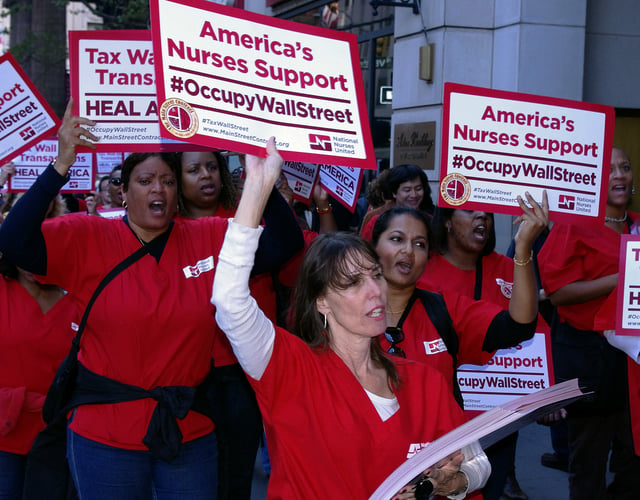
October 5, 2011, in Foley Square, members of National Nurses United labor union supporting OWS
During an October 6 news conference, President Barack Obama said, "I think it expresses the frustrations the American people feel, that we had the biggest financial crisis since the Great Depression, huge collateral damage all throughout the country ... and yet you're still seeing some of the same folks who acted irresponsibly trying to fight efforts to crack down on the abusive practices that got us into this in the first place."[231][232]
On October 5, 2011, noted commentator and political satirist Jon Stewart said in his Daily Show broadcast: "If the people who were supposed to fix our financial system had actually done it, the people who have no idea how to solve these problems wouldn't be getting shit for not offering solutions."[233]
Republican presidential candidate Mitt Romney said that while there were "bad actors" that needed to be "found and plucked out", he believes that targeting one industry or region of America is a mistake and views encouraging the Occupy Wall Street protests as "dangerous" and inciting "class warfare".[234][235] Romney later expressed sympathy for the movement, saying, "I look at what's happening on Wall Street and my view is, boy, I understand how those people feel."[236]
House Democratic Leader Rep. Nancy Pelosi said she supports the Occupy Wall Street movement.[237] In September, various labor unions, including the Transport Workers Union of America Local 100 and the New York Metro 32BJ Service Employees International Union, pledged their support for demonstrators.[238]
On October 19, 2011, Greenpeace Executive Director Phil Radford spoke on behalf of Greenpeace supporting Occupy Wall Street protesters, stating: "We stand – as individuals and an organization – with Occupiers of all walks of life who peacefully stand up for a just, democratic, green and peaceful future."[241]
In November 2011, Public Policy Polling did a national survey which found that 33% of voters supported OWS and 45% opposed it, with 22% not sure. 43% of those polled had a higher opinion of the Tea Party movement than the Occupy movement.[243] In January 2012, a survey was released by Rasmussen Reports, in which 51% of likely voters found protesters to be a public nuisance, while 39% saw it as a valid protest movement representing the people.[244]
Pulitzer Prize–winning journalist Chris Hedges, a supporter of the movement, argues that OWS had popular support and "articulated the concerns of the majority of citizens."[245]
American political philosopher Jodi Dean, while critical of the movements focus on autonomy, leaderlessness and horizontality which she argues was self-destructive, says that "Occupy ruptured the lie that 'what is good for Wall Street is good for Main Street'."[246]
Many notable figures joined the occupation, including David Crosby, Kanye West, Russell Simmons, Alec Baldwin, Susan Sarandon, Don King, Noam Chomsky, Jesse Jackson, Cornel West, and Michael Moore.[247]
Occupy Yale
Time Magazine: Person of the Year 2011
OWS was mentioned by Time Magazine in its 2011 selection of "The Protester" as Person of the Year.[251]
Occupy George
Criticism
A number of criticisms of Occupy Wall Street have emerged, both during the movement's most active period and subsequently after. These criticism include a lack of clear goals, false claim as the 99%, a lack of measurable change, trouble conveying its message, a failure to continue its support base, pursuing the wrong audience, and accusations of anti-Semitism.
Lack of clear goals
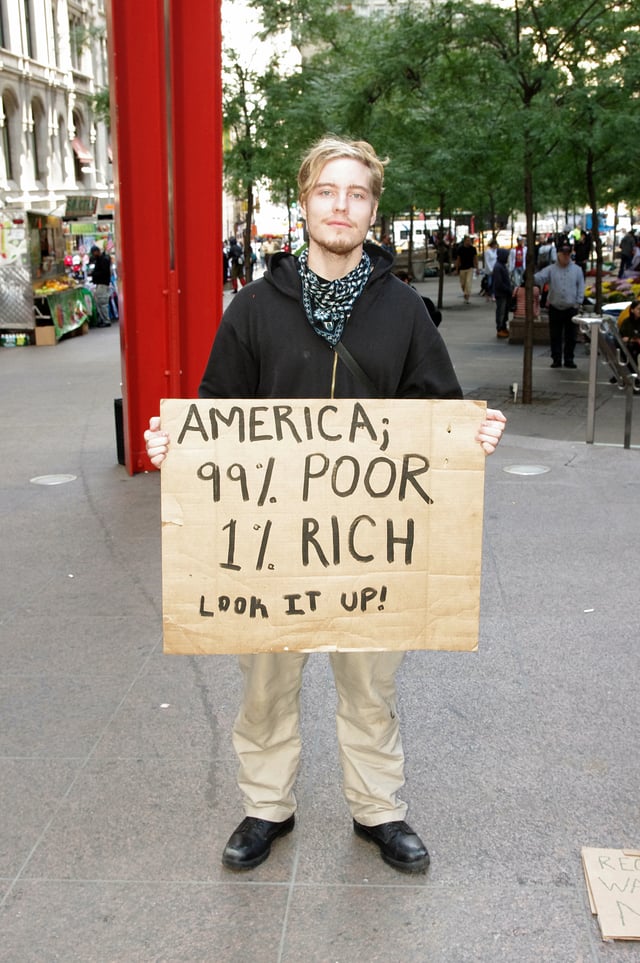
Although the movement's primary slogan was "we are the 99%," it was criticized for not encompassing the voice of the entire 99%, specifically lower class individuals and minorities
The Occupy Movement has been criticized for not having a set of clear demands that could be used to prompt formal policy change. This lack of agenda has been cited as the reason why the Occupy Movement fizzled before achieving any specific legislative changes. Although the lack of demands has simultaneously been argued as one of the advantages of the movement,[254] the protesters in Occupy rejected the idea of having only one demand, or a set of demands, and instead represented a host of broad demands that did not specifically allude to a desired policy agenda.[255][256]
Lack of minority representation
Although the movement's primary slogan was "We are the 99%," it was criticized for not encompassing the voice of the entire 99%, specifically lower class individuals and minorities. For example, it was characterized as being overwhelmingly white[257] and poorly representative of the needs of the immigrant population. The lack of African American presence was especially notable, with the movement being criticized in several news outlets and journal articles about its lack of inclusivity and racial diversity.[258][259][260][261]
Lack of measurable change
Some publications mentioned that the Occupy Wall Street Movement failed to spark any true institutional changes in banks and in Corporate America. This idea is supported by the number of scandals that continued to emerge following the financial crisis such as the London Whale incident, the LIBOR-fixing scandal, and the HSBC money laundering discovery. Furthermore, the idea of excess compensation through salaries and bonuses at Wall Street banks continued to be a contentious topic following the Occupy protests, especially as bonuses increased during a period of falling bank profits.[262][263][264]
Trouble conveying its message
Another criticism was the idea that the movement itself was having trouble conveying its actual message. The movement was criticized for demonizing the rich and establishing a theme of class warfare.[265][266][267] Another issue that was raised was that the Occupy Movement was attempting to indict the entire 1% and argue for wealth redistribution, when in fact, the focus of the movement was centered around upward mobility and fairness for all through government regulation and taxation.[268][269]
Failure to continue its support base
The movement was also criticized for not building a sustainable base of support and instead fading quickly after its initial spark in late 2011 through early 2012.[270] This may be attributed to Occupy's lack of legislative victories, which left the protestors with a lack of measurable goals. It was also argued that the movement was too tied to its base, Zuccotti Park. Evidence of this lies in the fact that when the police evicted the protestors on November 15, the movement largely dissipated.[271][268] While there is evidence that the movement had an enduring impact, protests and direct mentions of the Occupy Movement quickly became uncommon.[272][273][270]
Wrong audience
Many people felt that Occupy had the wrong target in mind, and that Washington, politicians, or the Federal Reserve should have received much of the rebuke[274][275] for ignoring the warning signs leading up to the financial crisis and not taking action more quickly. In addition, the movement was criticized for demonizing banks and the entire financial industry, with the argument being that only a certain portion of Wall Street workers contributed to the actions that eventually sparked the financial crisis.[256][276]
Anti-semitism accusations
Many Occupy Wall Street protests have included anti-zionist and anti-Semitic slogans and signage such as "Jews control Wall Street" or "Zionist Jews who are running the big banks and the Federal Reserve". As a result, the Occupy Wall Street Movement has been confronted with accusations of anti-Semitism by major US media.[277][278][279][280][281]
Subsequent activity
May Day 2012
Occupy Wall Street mounted an ambitious call for a citywide general strike and day of action on May 1, 2012. Recalls journalist Nathan Schneider, "The idea of a general strike had been circulating in the movement since who-knows-when. There was a woman who called for it back on September 17th. Occupy Oakland tried to mount one on November 2nd, with some success and a few broken windows. Soon after, Occupy LA took the lead in announcing a target that seemed sufficiently far off to be feasible, and sufficiently traditional to seem plausible: May Day."[282] Though the day fell short of its wildest ambitions, tens of thousands of people participated in a march through New York City, demonstrating continued support for Occupy Wall Street's cause and concerns.
Occupy Sandy
Occupy Sandy is an organized relief effort created to assist the victims of Hurricane Sandy in the northeastern United States. Occupy Sandy is made up of former and present Occupy Wall Street protesters, other members of the Occupy movement, and former non-Occupy volunteers.[283]
3rd anniversary
Three years after the original occupation, there were fewer people actively involved in Occupy than at its height. However, a number of groups that formed during the occupation or resulted from connections made at that time were still active.[284]
On-going efforts
Strike Debt
To celebrate the third anniversary of the occupation of Zuccotti Park, an Occupy Wall Street campaign called "Strike Debt" announced it had wiped out almost $4 million in student loans, amounting to the indebtedness of 2,761 students. The loans were all held by students of Everest College, a for profit college that operates Corinthian Colleges, Inc. which in turn owns Everest University, Everest Institute, Heald College, and WyoTech.
We chose Everest because it is the most blatant con job on the higher ed landscape. It's time for all student debtors to get relief from their crushing burden.
The loans became available when the banks holding defaulted loans put the bad loans up for sale. Once purchased, the group chose to forgive the loans. The funds to purchase the loans came from donations to the Rolling Jubilee Fund [313] , part of the Occupy Student Debt program. As of September 2014, the group claimed to have wiped out almost $19 million in debt.[285]
As of September 2014, Rolling Jubilee claims to have cancelled more than $15 million in medical debt.[286]
Occupy the SEC
Occupy the SEC came together during the occupation. The group seeks to represent the 99% in the regulatory process. They first attracted attention in 2012 when they submitted a 325-page comment letter on the Volcker Rule portion of Dodd Frank.[289]
Alternative Banking
Another offshoot of the Occupy Movement, calling itself the OWS Alternative Banking Group, was established during the occupation of Zuccotti Park in 2011.[290] In 2013, the group published a book titled "Occupy Finance" and distributed copies in Zuccotti Park at the second anniversary and elsewhere.[291] FT Alphaville gave it "two thumbs up for discussable policy proposals" while the New York Times Dealbook called it "a guide to the financial system and the events surrounding the crisis, and it proposes a policy framework that it calls 'popular regulation.'"[292][293] The group continues to meet weekly at Columbia University including a speaker series.[294] The group started a blog in the Huffington Post in 2014.[295]
Alternative Banking ran Occupy Summer School at the Urban Assembly Institute of Math and Science for Young Women in July 2015.[296]
This group rebranded itself as Occupy the Future in 2018 because their discussions had drifted to topics less directly related to banking.
Influence on movement for higher wages
Commentators describe Occupy Wall Street as having influenced the fast food worker strikes.[297] Occupy Wall Street organizers also contributed to a worker campaign at Hot and Crusty cafe in New York City, helping them obtain higher wages and the right to form a union by working with a worker center.[298] Occupy Wall Street has been credited with reintroducing a strong emphasis on income inequality into broad political discourse and, relatedly, for inspiring the fight for a $15 minimum wage.[299]
See also
15 October 2011 global protests
2011 United States public employee protests
2011 Wisconsin protests
2011 protests in Spain
2013 protests in Brazil
2013 protests in Turkey
2014 Hong Kong protests
UC Davis pepper-spray incident
Bonus army 1932
List of Occupy movement topics
Poor People's Campaign 1968
Radical media
Nuit Debout
List of incidents of civil unrest in the United States
Post-democracy
List of protests in the 21st century


